2. 西藏自治区气候中心, 拉萨 850000;
3. 西藏自治区气象服务中心, 拉萨 850000
土壤湿度作为陆面过程研究中的重要物理参数之一, 是水土资源合理利用和抗旱救灾决策的主要依据, 它积累了地表水文过程的大部分信息, 通过影响地表的反照率、陆面植被的生长状况以及蒸发等来改变陆-气之间的能量交换, 土壤湿度的变化会影响土壤本身的热力性质和水文过程, 影响到气候变化和异常。同时, 气候变化也在通过陆-气相互作用对土壤湿度的变化特征产生深刻的影响。
在20世纪50年代, Namias(1958)就发现土壤水分的季节性异常对大气环流季节性变化有重要作用。目前中国对于土壤湿度研究侧重于中国东部、青藏高原不同区域土壤湿度的时空分布特征及其对降水的影响。马柱国等(2000)分析了中国东部不同区域土壤湿度、降水和气温的变化趋势、年际变化及它们之间的相互关系; 左志燕和张人禾(2007, 2008)分析了中国东部春季土壤湿度的时空变化特征, 发现春季从长江中下游到华北的土壤湿度偏湿, 东北土壤湿度偏干时, 对应着中国夏季东北和长江流域降水偏多, 华北和南方降水偏少, 且春季土壤湿度通过影响东亚夏季风的强度进而对中国夏季降水产生影响; 以往研究(王晓婷等, 2009; 戴长勇和左志燕, 2010; Zhan et al, 2011, 2012; 梁乐宁和陈海山, 2010)指出, 无论中国东部, 还是黄河以南地区, 前期土壤湿度与夏季降水变化存在较好的相关; 春季华南土壤湿度与夏季华南降水呈正相关, 而与长江流域及其以北地区降水呈负相关; 数值模拟(李巧萍等, 2007)表明春季初始土壤湿度异常使得江淮流域地区降水增大, 地面空气增湿、蒸发加大; 高楚杰等(2013, 2014)认为当春季南海海温异常偏高(低)时, 我国西南地区东部土壤出现异常偏干, 夏季长江流域降水偏多、东南沿海地区降水偏少, 反之亦然; 数值模拟研究(史一丛, 2014)表明, 人为降低模拟的春季初始土壤温、湿度, 会对东亚及周围地区温度和能量、气候有显著的影响。此外, 较多研究(陈少勇等, 2008; 王磊, 2008; 姜丽霞等, 2009; 岳平等, 2013; 姚玉璧等, 2015)分析了黄土高原、东北地区等区域土壤湿度分布特征及其气候响应。由此可见, 前期土壤湿度异常是造成后期降水异常的原因之一。
青藏高原热力作用对高原本身及东亚乃至全球气候变化具有十分重要的影响。因此, 研究青藏高原的土壤温湿时空分布特征有着十分重要的意义。杨梅学等(1999a, 1999b, 2000a, 2000b, 2002)分析了藏北高原土壤温湿的分布特征以及冻融过程在干湿季转换、热量分布变化中的作用; 有研究(赵逸舟等, 2007; 杨健等, 2012; 谢志清等, 2005)探讨了高原不同下垫面土壤湿度的时空分布特征及其与降水、土壤消融之间的相互作用; 张娟等(2015)利用温、湿监测数据及同步气象数据资料, 分析了巴塘高寒草甸日、年土壤温湿变化状况; 也有研究(王澄海和尚大成, 2007; 郭东林和杨梅学, 2010)指出, 土壤湿度变化和高原干湿季转换及湿季降水存在联系, 水热耦合模式能够再现青藏高原中部土壤未冻水含量随时间的实际变化趋势; 刘川等(2015)综合评估了再分析资料和陆面模式资料中土壤温湿度数据在青藏高原的适用性。对青藏高原土壤湿度对下游地区降水的影响(王瑞等, 2009; 张雯等, 2015)而言, 青藏高原春季土壤偏湿, 使得我国东部雨带偏北, 华北地区多雨, 江淮地区降水偏少, 华南地区降水偏多。
综上所述, 以往学者们大多数分析了中国东部、青藏高原不同区域土壤湿度的分布特征, 取得了较为丰富的研究成果。但是, 针对青藏高原整体长序列土壤湿度资料分析及其气候效应的研究相对较少。本文将基于美国气候预测中心的土壤湿度以及格点降水资料, 探讨近50年来青藏高原土壤湿度时空分布特征以及高原春季土壤湿度对长江中下游降水的影响。这不仅有助于理解土壤湿度、降水之间的相互作用, 对了解大尺度天气过程的能量和水分交换过程, 提高全球增暖的条件下气候干湿变化的预测水平有重要的意义。
2 资料和研究区域土壤湿度资料来源于美国气候预测中心(Climate Prediction Center, CPC), 是通过全球观测降水和气温驱动陆面过程模型(Fan and Van, 2004)获得。数据空间分辨率为0.5°×0.5°, 垂直方向上为一层(0~160 cm), 土壤湿度单位为mm3·mm-3。该数据不仅能够较好地再现出美国伊利诺伊地区土壤湿度观测的季节和年际变化过程, 并且能很好地反映中国、印度、蒙古和俄罗斯等地的土壤湿度季节和年际变化(Van et al, 2003)。詹艳玲等(2011, 2012)指出, CPC土壤湿度可以较好地再现中国东部区域观测土壤湿度的空间分布及年际变化特征。
为了解该土壤湿度资料在高原地区的适用性, 采用中国气象局国家气象信息中心的多源土壤湿度融合分析产品(CLDAS-CMA Land Data Assimilation System)以及那曲地区观测数据与CPC数据进行了对比分析。CLDAS融合数据通过将地面观测、卫星观测和数值模式产品等多种来源数据进行融合, 获得高质量的气象资料以驱动陆面模式, 计算出的土壤湿度符合中国区域土壤湿度的分布规律(朱晨, 2013)。通过比较发现, CPC土壤湿度基本可以反映高原土壤湿度的空间分布和时间演变状况。因此, 认为可以选用CPC土壤湿度资料来替代观测土壤湿度, 用以分析青藏高原土壤湿度的时空分布特征。
采用的降水量为中国地面降水月值0.5°×0.5°格点数据集(V2.0), 该数据集基于国家气象信息中心基础资料专项最新整编的中国地面(18.25°N-53.75°N, 72.25°E-135.75°E)约2400个台站降水资料, 利用ANUSPLIN软件的薄盘样条法(Thin Plate Spline, TPS)进行空间插值, 生成1961年至最新时段的水平分辨率0.5°×0.5°的中国降水月值格点数据。
就资料时段和研究范围而言, 除了在分析土壤湿度年代际变化时, 资料时段为1960-2014年之外, 其他资料时段均为1961-2014年, 选取1981-2010年作为多年气候平均值的资料时段。采用由中国科学院张镱锂等(2002)制作的青藏高原边界, 高原在中国境内部分为西起帕米尔高原, 东至横断山脉, 南自喜马拉雅山脉南缘, 北迄昆仑-祁连山北侧的区域。依据以往研究(司东等, 2010), 选择28.25°N-33.75°N, 110.25°E-121.75°E区域作为长江中下游降水的研究范围。研究方法主要有线性趋势、相关分析和相关系数检验, 用于分析土壤湿度年际-年代际尺度上的变化趋势和显著性检验以及土壤湿度与降水之间的关系。
3 结果分析 3.1 土壤湿度的空间分布特征 3.1.1 空间分布青藏高原年土壤湿度的空间分布(图 1a)表明, 近50年土壤湿度随着平均海拔高度的上升呈现从东南向西北逐渐减少的分布特征。土壤湿度最大的区域位于高原南部尤其是西藏东南部, 湿度最大值可以达到0.58 mm3·mm-3, 其次是高原东南边缘区域; 高原北部的柴达木盆地一带最为干燥, 最小土壤湿度仅为0.01 mm3·mm-3。青藏高原东南部降水多且植被明显好于西北部, 高植被覆盖具有较强固水能力, 对应于土壤湿度高值区, 土壤湿度的地理分布特征较好地反映了每个区域气候带、海拔高度和下垫面植被类型特征。类似地, 青藏高原各季节土壤湿度呈现与年土壤湿度相似的空间分布特征, 极值区域也与年土壤湿度空间分布基本一致。高原春季土壤湿度(图 1b)比较小, 属于较干燥季节, 土壤湿度处于0.01~0.49 mm3·mm-3之间, 高值区位于高原东南部, 可能与高原春季低温少雨天气存在联系; 夏季土壤湿度(图略)逐渐增加, 这可能是由于气温回升, 高原地区冰雪和冻土融化, 加之高原雨季到来, 降水量增加, 这些水分渗透至土壤层中, 致使土壤湿度增加, 土壤湿度处于0.01~0.68 mm3·mm-3之间; 秋季高原总体上土壤湿度(图 1c)有所减少, 但是, 由于高原东南部雨季较长以及植被较好的固水能力, 土壤湿度(0.01~0.64 mm3·mm-3)仍然维持与夏季土壤湿度比较接近的量级; 随着冬季高原地区急剧降温, 土壤湿度(图略)逐渐减少, 土壤湿度处于0.01~0.48 mm3·mm-3之间; 总之, 年和不同季节土壤湿度空间分布特征基本一致, 均呈现从东南向西北减少的趋势, 与高原植被、降水量的空间分布特征比较类似。
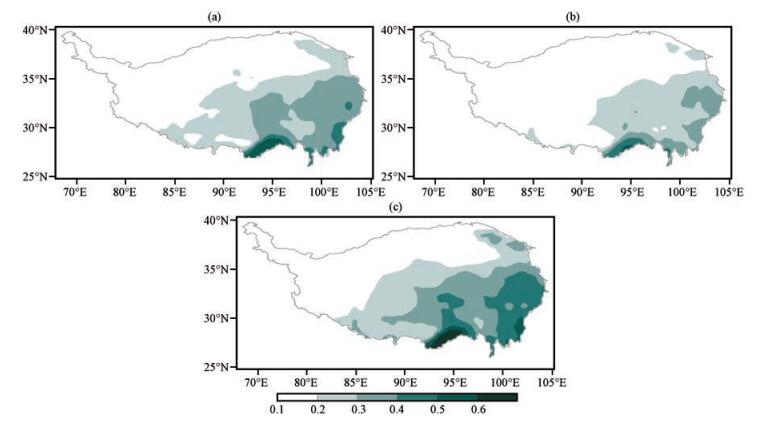
|
图 1 1961-2014年青藏高原全年(a)和春季(b)、秋季(c)土壤湿度的空间分布(单位: mm3·mm-3) Figure 1 Spatial distribution of soil moisture in annual (a), spring (b) and autumn (c) over the Qinghai-Tibetan Plateau from 1961 to 2014.Unit: mm3·mm-3 |
逐月土壤湿度(图略)空间分布显示出与年、季节空间分布比较相似的特征, 即1-5月土壤湿度大值区分布在西藏东南部, 6月以后, 随着雨季的来临, 高原土壤湿度逐渐增加, 在9-10月达到湿度最大值, 11月以后湿度逐渐减小。但是, 总体上11-12月湿度大于1-5月土壤湿度。从土壤湿度逐月高、低值中心位置来看, 土壤湿度高值区位于西藏东南部, 最大值处于0.44~0.70 mm3·mm-3之间; 低值区位于柴达木盆地, 最低值为0.01 mm3·mm-3左右, 体现出青藏高原土壤湿度显著的季节性差异和区域性特征。
3.1.2 空间变化趋势土壤湿度多年的空间变化趋势(图 2)表明, 近50年来青藏高原大部土壤湿度呈增加趋势, 大部分区域增加幅度在0~0.01 mm3·mm-3·a-1之间, 增加最显著的区域位于西藏南部和北部; 只有高原西北部以及高原东南部边缘土壤湿度呈减少趋势, 其中以西藏东南部减少较为显著, 减少幅度可以达到0.05 mm3.mm-3·a-1左右; 不同季节土壤湿度多年变化趋势(图略)的空间分布特征与年土壤湿度变化趋势比较接近, 仅与后者存在增加或减少幅度上的差异。
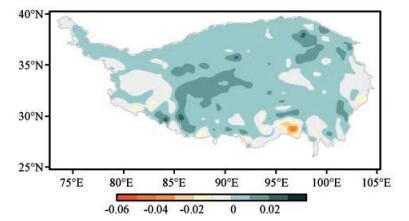
|
图 2 1961-2014年青藏高原土壤湿度的年变化趋势(单位: mm3·mm-3·a-1) Figure 2 Variation trend of annual soil moisture over the Qinghai-Tibetan Plateau from 1961 to 2014.Unit: mm3·mm-3·a-1 |
青藏高原区域平均的逐月土壤湿度变化曲线(图 3)表明, 1月到4月土壤湿度逐渐减少, 并在4月达到一年中的最低值0.15 mm3·mm-3, 5月开始急剧增加, 9月达到一年中的最大值, 达0.22 mm3·mm-3, 随后土壤湿度开始逐渐减少; 整体上土壤湿度呈现“单峰”型变化, 在夏半年土壤湿度量值比较大, 冬半年量值较小, 表明降水对土壤湿度有明显的影响(赵逸舟等, 2009)。根据地表水分收支方程可知, 降水增多有利于土壤湿度的增加, 10月以后, 雨季结束, 土壤湿度迅速下降, 反映了土壤湿度的季节变化以及降水对土壤湿度的影响。
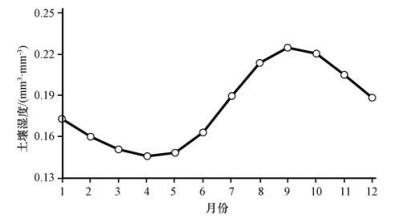
|
图 3 1961-2014年青藏高原土壤湿度的月变化 Figure 3 Monthly variation of soil moisture over the Qinghai-Tibetan Plateau from 1961 to 2014 |
近50年土壤湿度变化曲线(图 4)表明, 青藏高原年土壤湿度在1961-1964年之间呈略微增加, 1964-1981年期间土壤湿度在0.17~0.19 mm3·mm-3之间振荡, 之后开始下降, 1984年达到一个低值0.16 mm3·mm-3, 接着土壤湿度显著增加, 1988年达到0.19 mm3·mm-3, 之后急剧下降, 1995年达到近50年中最低值, 为0.14 mm3·mm-3, 随后土壤湿度逐渐增加, 2000年以后基本维持在0.19 mm3·mm-3以上的高值, 呈现较为平稳的变化, 其中, 2008年达到近50年中的最大值, 达0.21 mm3·mm-3; 不同季节土壤湿度的时间演变与年土壤湿度整体变化趋势比较一致, 只是土壤湿度极值大小和出现年份存在着差异。
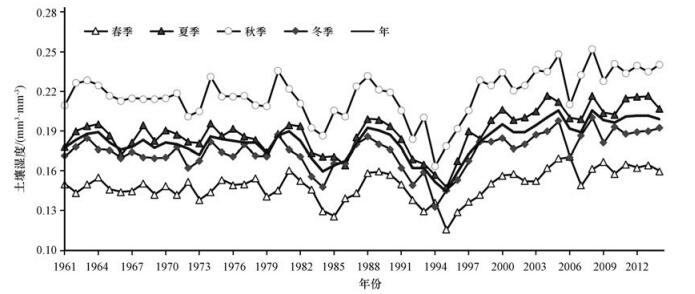
|
图 4 1961-2014年青藏高原全年和不同季节土壤湿度的年际变化 Figure 4 Inter-annual variation of annual and seasonal soil moisture over the Qinghai-Tibetan Plateau from 1961 to 2014 |
近50年来青藏高原年和不同季节土壤湿度均呈显著增加趋势。其中, 年土壤湿度以0.0032 mm3·mm-3·(10a)-1的速度增加; 春季和冬季增幅分别为0.00259 mm3·mm-3·(10a)-1和0.00261 mm3·mm-3·(10a)-1, 夏季为0.0047 mm3·mm-3·(10a)-1, 秋季为0.0034 mm3·mm-3·(10a)-1; 可以看出, 夏季土壤湿度增加最为显著, 其次是秋季, 这可能与近年来青藏高原大部分区域降水量逐渐增加存在密切关系; 无论年或不同季节高原土壤湿度变化趋势均通过95%以上的信度检验。不同时段青藏高原土壤湿度54年(1961-2014年)区域平均值表明, 年土壤湿度为0.18 mm3·mm-3, 秋季土壤湿度最大, 可以达到0.22 mm3·mm-3, 其次是夏季(0.19 mm3·mm-3)和冬季(0.17 mm3·mm-3), 土壤湿度最小值出现在春季(0.15 mm3·mm-3)。
3.2.3 年代际分布青藏高原土壤湿度的年代际分布(表 1)表明, 年土壤湿度处于0.169~0.200 mm3·mm-3之间, 土壤湿度从20世纪60年代(0.180 mm3·mm-3)至90年代(0.169 mm3·mm-3)呈略微减少趋势; 21世纪00年代开始, 土壤湿度呈显著增加趋势, 到2010-2014年增加为0.200 mm3·mm-3; 从不同季节土壤湿度的年代际变化可见, 春季、夏季土壤湿度从20世纪60年代至70年代呈略微增加趋势, 随后逐渐减少, 90年代达到土壤湿度最低值, 分别为0.139 mm3·mm-3和0.176 mm3·mm-3, 21世纪00年代开始呈增加趋势; 秋季、冬季土壤湿度从20世纪60年代至90年代呈减少趋势, 随后土壤湿度呈略微增加趋势。由此可见, 不同时段青藏高原土壤湿度的最小值均出现在20世纪90年代, 最大值出现在2010-2014年。
| 表 1 1960-2014年青藏高原土壤湿度的年代际分布 Table 1 Inter-decadal distribution of annual and seasonal soil moisture over the Qinghai-Tibetan Plateau from 1960 to 2014 |
青藏高原土壤湿度对我国东部雨带位置和降水量有着密切联系(王瑞等, 2009; 张雯等, 2015)。为此, 做出了多年平均的土壤湿度与长江中下游降水量逐月变化曲线(图 5)。从图 5可以看出, 逐月土壤湿度和降水量呈现较弱的反相关。1-6月长江中下游降水量呈现增加趋势, 6月达到最大值, 随后逐渐减少; 而土壤湿度1-4月呈下降趋势, 5-9月呈增加趋势, 在9月达到最大值, 之后逐渐下降, 说明青藏高原土壤湿度和长江中下游降水量两者之间存在着2-3个月的滞后相关, 降水量增加会影响到土壤湿度的大小。
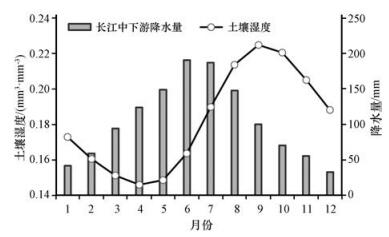
|
图 5 1961-2014年青藏高原逐月土壤湿度与长江中下游降水量的变化曲线 Figure 5 Monthly variation of soil moisture over the Qinghai-Tibetan Plateau and precipitation in the mid-lower reaches of Yangtze River Basin from 1961 to 2014 |
根据上述分析, 选择青藏高原春季土壤湿度, 计算了春季高原土壤湿度与长江中下游6、7月降水量之间的相关系数(图 6)。由图 6可见, 青藏高原春季土壤湿度与6月降水量(图 6a)在高原主体上呈反相关, 通过了90%以上显著性检验的负相关区域主要位于高原东北部以及高原西南部, 其他区域基本上为弱的负相关区域; 春季土壤湿度与7月降水量(图 6b)总体上也呈反相关, 通过90%以上显著性检验的负相关区域主要位于高原中部和东南部地区, 其他区域基本也为弱的负相关区域, 但是, 在高原西北部存在部分正相关区域。由此可见, 无论6月还是7月, 长江中下游降水量与高原春季土壤湿度相关系数基本上呈负相关, 6月通过显著性检验的负相关区位于高原西南部和东北部, 7月通过显著性检验的负相关区位于高原南部, 并且在高原西北区域存在通过90%以上显著性水平检验的正相关区。

|
图 6 青藏高原春季土壤湿度与长江中下游6(a)、7(b)月降水量的相关系数 黑线区域表示通过了90%以上的显著性水平检验 Figure 6 Coefficient of spring soil moisture over the Qinghai-Tibetan Plateau to precipitation in June (a) and July (b) over the mid-lower reaches of Yangtze River Basin. Black circle areas indicates regions have passed the significance level at 90% |
为了进一步探讨青藏高原春季土壤湿度和长江中下游降水量的关系, 依据1961-2014年青藏高原春季土壤湿度距平资料, 选取1984年, 1985年, 1993年, 1995年和1996年作为土壤湿度的低值年, 2005年, 2006年, 2009年, 2011年和2013年作为土壤湿度的高值年, 分别做出了土壤湿度干、湿年份合成的春季土壤湿度距平图(图 7), 以下简称为干年和湿年。可以看出, 干年(图 7a)中除了高原西北部分区域土壤湿度比多年气候平均值偏多之外, 其他区域土壤湿度基本小于气候平均值, 尤其以高原中部和东南部最为显著; 湿年(图 7b)土壤湿度的分布特征与干年总体上呈基本相反的分布, 除了高原西北部以及西藏东南部的部分区域土壤湿度比多年气候平均值偏少外, 其他区域土壤湿度基本上大于多年气候平均值, 说明了选择的高原春季土壤湿度干、湿年份具有较好的代表性。依据青藏高原春季土壤湿度干、湿年份, 做出了对应的长江中下游6、7月多年合成降水量距平百分率的空间分布(以7月为例, 图 8)。由图 8可以看出, 青藏高原春季土壤湿度低值年, 长江中下游大部6月降水量(图略)偏多10~60%, 只有少数区域偏少, 整体上降水量偏多; 而土壤湿度高值年对应的降水距平百分率总体偏少; 从7月降水距平百分率来看, 也是干年(图 8a)对应降水量偏多, 湿年(图 8b)对应降水量偏少; 这也从侧面说明了青藏高原春季土壤湿度与长江中下游降水呈负相关关系。

|
图 7 青藏高原春季土壤湿度干(a)、湿(b)年的空间分布(单位: mm3·mm-3) Figure 7 Distribution of spring soil moisture in dry (a) and wet (b) years over the Qinghai-Tibetan Plateau.Unit: mm3·mm-3 |

|
图 8 青藏高原春季土壤湿度(a)干、(b)湿年对应的长江中下游7月降水距平百分率(单位: %) Figure 8 Percentage of precipitation anomaly in July in years with (a) dry and (b) wet spring soil moisture over the Qinghai-Tibetan Plateau.Unit: % |
由此可见, 土壤湿度的异常改变了下垫面加热场的状态, 引起大气环流异常, 导致了夏季降水的异常(高楚杰等, 2013; 王瑞等, 2009); 而春季热力作用与我国江淮地区夏季降水有很好的正相关关系, 春季高原热力作用弱, 夏季江淮地区降水少(刘新等, 2007); 夏季高原主体东部和东南侧热源强时, 江淮流域降水增多(敖婷和李跃清, 2015)。说明了青藏高原土壤湿度偏湿, 使地面蒸发、潜热通量增加, 感热通量、地表温度降低, 高原地表的加热作用减弱, 导致环流的季节性转换偏晚, 使得我国雨带偏北, 江淮地区降水偏少, 反之亦然。
4 结论通过对青藏高原土壤湿度时空特征以及春季土壤湿度与长江中下游6、7月降水关系的分析, 得到了以下主要结论:
(1) 青藏高原年和不同季节的土壤湿度空间分布特征基本一致, 均呈现从东南向西北减少的趋势。区域平均的土壤湿度显示出高原土壤春季最为干燥, 秋季和夏季较为湿润的分布特征。
(2) 近50年来青藏高原大部的年、季节土壤湿度均呈略微增加趋势, 年、季土壤湿度从20世纪60年代至90年代基本上呈减少, 21世纪00年代开始呈缓慢增加趋势。青藏高原春季土壤湿度与长江中下游降水量青藏高原基本呈负相关关系。通过信度检验的负相关区在6月位于高原东北部和西南部, 7月位于高原南部, 且高原西北部分区域春季土壤湿度与7月降水量存在显著正相关。高原春季土壤湿度通过对高原地表温度的作用, 进而影响到高原热力特征、大气环流以及长江中下游降水的分布特征。
本文侧重分析了近54年来青藏高原土壤湿度的时空分布特征, 以及春季高原土壤湿度与长江中下游降水的关系, 没有涉及青藏高原土壤湿度的垂直结构特征, 高原春季土壤湿度影响长江中下游降水的物理机制, 高原土壤湿度的空间分布类型及其与下垫面条件等要素的关系, 这些都有待于将来借助更丰富的观测资料和数值模拟手段做进一步研究。
致谢 文中土壤湿度数据和降水格点资料分别来源于美国气候预测中心(http://www.esrl.noaa.gov/psd/data/gridded/data.cpcsoil.html)和中国气象局国家气象信息中心(http://cdc.nmic.cn/home.do)。| Fan Y, Van den Dool H. 2004. The CPC global monthly soil moisture dataset at 0.5 degree resolution for 1948-present[J]. J Geophys Res, 109(D10): D10102. DOI:10.1029/2003JD004345 | |
| Gao Chujie, Chen Haishan, Xu Bei, et al. 2014. Possible relationships among south china sea SSTA, soil moisture anomalies in southwest china and summer precipitation in eastern China[J]. J Trop Meteor, 20(3): 228–235. | |
| Namias J.1958.Persistence of midtropospheric circulation between adjacent months and seasons[M].Rossby Memorial Volume, Rockefeller Institute press and Oxford University Press, 240-248. | |
| Van den Dool H., Huang J, Fan Y. 2003. Performance and analysis of the constructed analogue method applied to US soil moisture over 19812001[J]. J Geophys Res, 108(D16): D168617. DOI:10.1029/2002JD003114 | |
| Zhan Yanling, Lin Zhaohui. 2011. The relationship between June precipitation over the mid-lower reaches of the Yangtze river basin and spring soil moisture over the east Asian monsoon region[J]. Acta Meteor Sinica, 25(3): 355–363. DOI:10.1007/s13351-011-0310-6 | |
| 敖婷, 李跃清. 2015. 夏季青藏高原及周边热力特征与东亚降水的区域关系[J]. 高原气象, 34(5): 1204–1216. DOI:10.7522/j.issn.1000-0534.2014.00100Ao Ting, Li Yueqing. 2015. Summertime thermal characteristics over Qinghai-Xizang Plateau and surrounding areas and its relationship with precipitation in East Asia[J]. Plateau Meteor, 34(5): 1204–1216. DOI:10.7522/j.issn.1000-0534.2014.00100 | |
| 陈少勇, 郭凯忠, 董安祥. 2008. 黄土高原土壤湿度变化规律研究[J]. 高原气象, 27(3): 530–537. Chen Shaoyong, Guo Kaizhong, Dong Anxiang. 2008. Research of variety rule of soil humidity in Loess Plateau of China[J]. Plateau Meteor, 27(3): 530–537. | |
| 戴长勇, 左志燕. 2010. 中国东部前冬、春土壤湿度与夏季气候的关系[J]. 气象科技, 38(3): 300–305. Dai Changyong, Zuo Zhiyan. 2010. Relationship between precious winter and spring soil moisture and summer climate in eastern China[J]. Meteorological Science and Technology, 38(3): 300–305. | |
| 高楚杰, 陈海山, 许蓓, 等. 2013. 南海海温和西南地区土壤湿度异常与中国东部夏季降水的可能联系[J]. 热带气象学报, 29(1): 75–82. Gao Chujie, Chen Haishan, Xu Bei, et al. 2013. Possible relationships among south China sea SSTA, soil moisture anomalies in southwest China and summer precipitation in eastern China[J]. J Trop Meteor, 29(1): 75–82. | |
| 郭东林, 杨梅学. 2010. SHAW模式对青藏高原中部季节冻土区土壤温、湿度的模拟[J]. 高原气象, 29(6): 1369–1377. Guo Donglin, Yang Meixue. 2010. Simulation of soil moisture and moisture in seasonally frozen ground of central Tibetan Plateau by SHAW model[J]. Plateau Meteor, 29(6): 1369–1377. | |
| 姜丽霞, 李帅, 纪仰慧, 等. 2009. 19802005年松嫩平原土壤湿度对气候变化的响应[J]. 生态学报.2009, 20(1): 91–97. Jiang Lixia, Li Shuai, Ji Yanghui, et al. 2009. Response of soil humidity on Songnen plain to climate change in 19802005[J]. Chinese J Appl Ecology, 20(1): 91–97. | |
| 李巧萍, 丁一汇, 董文杰. 2007. 土壤湿度异常对区域短期气候影响的数值模拟试验[J]. 应用气象学报, 18(1): 1–11. DOI:10.11898/1001-7313.20070102Li Qiaoping, Ding Yihui, Dong Wenjie. 2007. A numerical study on effects of the soil moisture upon the regional short-term climate[J]. J Appl Meteor Sci, 18(1): 1–11. DOI:10.11898/1001-7313.20070102 | |
| 梁乐宁, 陈海山. 2010. 春季华南土壤湿度异常与中国夏季降水的可能联系[J]. 大气科学学报, 33(5): 536–546. Liang lening, Chen Haishan. 2010. Possible linkage between spring soil moisture anonalies over south China and summer rainfall in China[J]. Transactions of Atmospheric Science, 33(5): 536–546. | |
| 刘川, 余晔, 解晋, 等. 2015. 多套土壤温湿度资料在青藏高原的适用性[J]. 高原气象, 34(3): 653–665. DOI:10.7522/j.issn.1000-0534.2015.00034Liu Chuan, Yu Ye, Xie Jing, et al. 2015. Applicability of soil temperature and moisture in several datasets over Qinghai-Xizang Plateau[J]. Plateau Meteor, 34(3): 653–665. DOI:10.7522/j.issn.1000-0534.2015.00034 | |
| 刘新, 李伟平, 许晃雄, 等. 2007. 青藏高原加热对东亚地区夏季降水的影响[J]. 高原气象, 26(6): 1287–1292. Liu Xin, Li Weiping, Xu Huangxiong, et al. 2007. The effect of Tibetan Plateau heating on the east Asian summer precipitation[J]. Plateau Meteor, 26(6): 1287–1292. | |
| 马柱国, 魏和林, 符淙斌. 2000. 中国东部区域土壤湿度的变化及其与气候变率的关系[J]. 气象学报, 58(3): 278–287. DOI:10.11676/qxxb2000.029Ma Zhuguo, Wei Helin, Fu Congbin. 2000. Relationship between regional soil moisture variation and climatic variability over east China[J]. Acta Meteor Sinica, 58(3): 278–287. DOI:10.11676/qxxb2000.029 | |
| 史一丛. 2014. 土壤湿度-温度初始异常对东亚及周边区域气候模拟的影响[D]. 南京: 南京信息工程大学. Shi Yicong.2014.Impacts of initial soil moisture and temperature anomalies on regional climate simulation on east Asia and its surrounding area[D].Nanjing:Nanjing University of Information Science and Technology. | |
| 司东, 丁一汇, 柳艳菊. 2010. 中国梅雨雨带年代际尺度上的北移及其原因[J]. 科学通报, 55(1): 68–73. Si Dong, Ding Yihui, Liu Yanju. 2010. Decadal northward shift of the Meiyu belt and the possible cause[J]. Chinese Sci Bull, 55(1): 68–73. | |
| 王澄海, 尚大成. 2007. 藏北高原土壤温、湿度变化在高原干湿季转换中的作用[J]. 高原气象, 26(4): 677–685. Wang Chenghai, Shang Dacheng. 2007. Effect of the variation of the soil temperature and moisture in the transition from dry season to wet season over northern Tibet Plateau[J]. Plateau Meteor, 26(4): 677–685. | |
| 王磊, 文军, 韦志刚, 等. 2008. 中国西北区西部土壤湿度及其气候响应[J]. 高原气象, 27(6): 1257–1266. Wang Lei, Wen Jun, Wei Zhigang, et al. 2008. Soil moisture over the west of northwest China and its response to climate[J]. Plateau Meteor, 27(6): 1257–1266. | |
| 王瑞, 李伟平, 刘新, 等. 2009. 青藏高原春季土壤湿度异常对我国夏季降水影响的模拟研究[J]. 高原气象, 28(6): 1233–1241. Wang Rui, Li Weiping, Liu Xin, et al. 2009. Simulation of the impacts of spring soil moisture over the Tibetan Plateau on summer precipitation in China[J]. Plateau Meteor, 28(6): 1233–1241. | |
| 王晓婷, 郭维栋, 钟中, 等. 2009. 中国东部土壤温度、湿度变化的长期趋势及其与气候背景的联系[J]. 地球科学进展, 24(2): 181–191. Wang Xiaoting, Guo Weidong, Zhong Zhong, et al. 2009. Long term trends of soil moisture and temperature change in east China in relationship with climate background[J]. Adv Earth Sci, 24(2): 181–191. | |
| 谢志清, 刘晶淼, 丁裕国, 等. 2005. 干旱及高寒荒漠区土壤温湿度特征及相互影响的分析[J]. 高原气象, 24(1): 16–22. Xie Zhiqing, Liu Jingmiao, Ding Yiguo, et al. 2005. Variation features of soil temperature and moisture content at dry and alpine desertification surface and their interaction analyse[J]. Plateau Meteor, 24(1): 16–22. | |
| 杨健, 马耀明. 2012. 青藏高原典型下垫面的土壤温湿特征[J]. 冰川冻土, 34(4): 813–820. Yang Jian, Ma Yaoming. 2012. Soil temperature and moisture features of typical underlying surface in the Tibetan Plateau[J]. Journal of Glaciology and Geocryology, 34(4): 813–820. | |
| 杨梅学, 姚檀栋, 丁永建, 等. 1999. 藏北高原D110点不同季节土壤温度的日变化特征[J]. 地理科学, 19(6): 570–574. Yang Meixue, Yao Tandong, Ding Yongjian, et al. 1999. The daily variation of the soil temperature in different seasons at site D110 in the northern part of Xizang Plateau[J]. Scientia Geographica Sinica, 19(6): 570–574. | |
| 杨梅学, 姚檀栋, ToshioKoike. 2000. 藏北高原土壤温度的变化特征[J]. 山地学报, 18(1): 13–17. Yang Meixue, Yao Tangdong, Toshio Koike. 2000. Variation features of soil temperature in northern Tibetan Plateau[J]. J Mountain Sci, 18(1): 13–17. | |
| 杨梅学, 姚檀栋, 何元庆. 2002. 青藏高原土壤水热分布特征及冻融过程在季节转换中的作用[J]. 山地学报, 20(5): 553–558. Yang Meixue, Yao Tangdong, He Yuanqing. 2002. The role of soil moisture-energy distribution and melting-freezing processes on seasonal shift in Tibetan Plateau[J]. J Mountain Sci, 20(5): 553–558. | |
| 杨梅学, 姚檀栋, 王绍令, 等. 1999. 藏北高原土壤温湿特征[J]. 地理研究, 18(3): 312–317. Yang Meixue, Yao Tandong, Wang Shaoling, et al. 1999. The features of soil temperature and moisture on northern Tibetan Plateau[J]. Geographical Research, 18(3): 312–317. | |
| 杨梅学, 姚檀栋, 勾晓华. 2000. 青藏公路沿线土壤的冻融过程及水热分布特征[J]. 自然科学进展, 10(5): 443–450. Yang Meixue, Yao Tandong, Gou Xiaohua. 2000. Melting-freezing processes and distribution of soil temperature along the Qinghai-Xizang highway[J]. Progress in Natural Science, 10(5): 443–450. | |
| 姚玉璧, 王劲松, 王莺, 等. 2015. 黄土高原春季干旱时空分异特征[J]. 高原气象, 34(1): 30–38. DOI:10.7522/j.issn.1000-0534.2013.00179Yao Yubi, Wang Jingsong, Wang Ying, et al. 2015. Anomaly temporal-spatial distribution of spring drought on Loess Plateau in China[J]. Plateau Meteor, 34(1): 30–38. DOI:10.7522/j.issn.1000-0534.2013.00179 | |
| 岳平, 张强, 王胜, 等. 2013. 黄土高原半干旱草地降水前后土壤的温、湿度及热力特征[J]. 中国沙漠, 33(6): 1766–1774. Yue Ping, Zhang Qiang, Wang Sheng, et al. 2013. Characteristics of soil temperature, moisture and heat pro-and post precipitation in semiarid grassland over Longzhong Loess Plateau[J]. J desert Res, 33(6): 1766–1774. | |
| 张娟, 沙占江, 徐维新. 2015. 青藏高原玉树地区巴塘高寒草甸土壤温湿特征分析[J]. 冰川冻土, 37(3): 635–642. Zhang Juan, Sha Zhanjiang, Xu Weixin. 2015. Variations of alpine meadow soil temperature and moisture in Batang, Yushu region of the Qinghai-Tibet Plateau[J]. Journal of Glaciology and Geocryology, 37(3): 635–642. | |
| 张雯, 王磊, 陈权亮. 2015. 青藏高原东部土壤湿度变化及其与中国降水的关系[J]. 成都信息工程学院学报, 30(1): 81–87. Zhang Wen, Wang Lei, Chen Quanliang. 2015. The soil moisture in Eastern of Qinghai-Tibet Plateau and its relationship with precipitation in China[J]. Journal of Chengdu University of Information Technology, 30(1): 81–87. | |
| 张镱锂, 李炳元, 郑度. 2003. 论青藏高原范围与面积[J]. 地理研究, 21(1): 1–8. Zhang Yili, Li Bingyuan, Zheng Du. 2003. A discussion on the boundary and area of the Tibetan Plateau in China[J]. Geographical Research, 21(1): 1–8. | |
| 詹艳玲, 林朝晖. 2012. 6月长江中下游降水和春季东亚季风区土壤湿度的关系[J]. 气象学报, 70(2): 236–243. Zhan Yanling, Lin Zhaohui. 2012. The relationship between June precipitation over mid-lower reaches of the Yangtze river basin and spring soil moisture over the east Asian monsoon region[J]. Acta Meteor Sinica, 70(2): 236–243. | |
| 赵逸舟, 马耀明, 马伟强, 等. 2007. 藏北高原土壤温湿变化特征分析[J]. 冰川冻土, 29(4): 578–583. Zhao Yizhou, Ma Yaoming, Ma Weiqiang, et al. 2007. Variations of soil temperature and soil moisture in northern Tibetan Plateau[J]. Journal of Glaciology and Geocryology, 29(4): 578–583. | |
| 朱晨, 师春香, 席琳, 等. 2013. 中国区域不同深度土壤湿度模拟和评估[J]. 气象科技, 41(3): 529–536. Zhu Chen, Shi Chunxiang, Xi Lin, et al. 2013. Simulation and assessment of soil moisture at different depths in China area[J]. Meteor Sci Technol, 41(3): 529–536. | |
| 左志燕, 张人禾. 2007. 中国东部夏季降水与春季土壤湿度的联系[J]. 科学通报, 54(14): 1722–1724. DOI:10.3321/j.issn:0023-074x.2007.14.021Zuo Zhiyan, Zhang Renhe. 2007. Relationship of summer precipitation and spring soil moisture in East China[J]. Chinese Sci Bull, 54(14): 1722–1724. DOI:10.3321/j.issn:0023-074x.2007.14.021 | |
| 左志燕, 张人禾. 2008. 中国东部春季土壤湿度的时空变化特征[J]. 中国科学D辑:地球科学, 38(11): 1428–1437. Zuo Zhiyan, Zhang Renhe. 2008. Spatial and temporal variations of spring soil moisture in east China[J]. Science China Earth Sciences, 38(11): 1428–1437. |
2. Tibet Climate Center, Lhasa 850000, China;
3. Tibet Meteorological Service Center, Lhasa 850000, China
 2017, Vol. 36
2017, Vol. 36